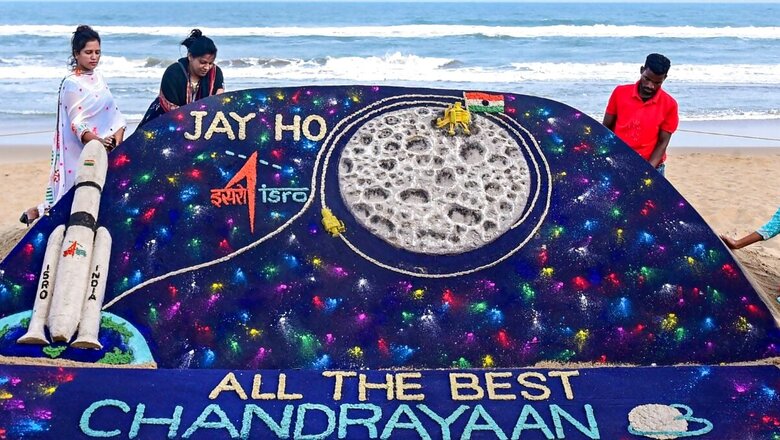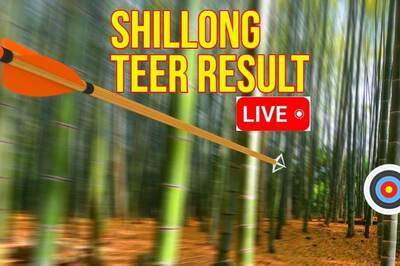
views
The day has finally arrived for which Indians across the world have been waiting since the launch of Chandrayaan-3 on July 14. At around 6.04 pm Wednesday, eyes will be glued to TV screens when Chandrayaan-3’s Lander Module (LM) is all set to land on the lunar surface as India eyes to become the first country to reach the uncharted south pole of Earth’s only natural satellite.
If the Chandrayaan-3 mission succeeds in making a touchdown on the moon and in landing a robotic lunar rover in ISRO’s second attempt in four years, India will become the fourth country to master the technology of soft-landing on the lunar surface after the US, China and the erstwhile Soviet Union.
Chandrayaan-3 Mission:The mission is on schedule.Systems are undergoing regular checks.Smooth sailing is continuing.The Mission Operations Complex (MOX) is buzzed with energy & excitement!
The live telecast of the landing operations at MOX/ISTRAC begins at 17:20 Hrs. IST… pic.twitter.com/Ucfg9HAvrY
— ISRO (@isro) August 22, 2023
The Rs 600 crore Chandrayaan-3 mission was launched on July 14 onboard Launch Vehicle Mark-III (LVM-3) rocket, for a 41-day voyage to reach near the lunar south pole.
Chandrayaan-3 All Set to Make History | When & Where to Watch
ISRO today confirmed that the Chandrayaan-3 mission is on schedule. “Systems are undergoing regular checks. Smooth sailing is continuing,” it said.
ISRO will broadcast the event live on August 23, from 5.27 pm IST on its official website. Chandrayaan-3 is expected to land on the moon around 6:04 pm.
Prime Minister Narendra Modi, who is on a visit to South Africa for the BRICS Summit, will be connecting with ISRO virtually to see the landing of Chandrayaan-3 on the moon on Wednesday evening.
Chandrayaan-3 Landing
According to ISRO officials, for landing, at around 30 km altitude, the lander enters the powered braking phase, and begins to use its four thruster engines by “retro firing” them to reach the surface of the moon, by gradually reducing the speed. This is to ensure the lander doesn’t crash, as the Moon’s gravity will also be in play.
Noting that on reaching an altitude of around 6.8 km, only two engines will be used, shutting down the other two, aimed at giving the reverse thrust to the lander as it descends further, they said, then, on reaching an altitude of about 150-100 metres, the lander using its sensors and cameras, would scan the surface to check whether there are any obstacles and then start descending to make a soft-landing.
ISRO Chairman S Somanath had recently said the most critical part of the landing will be the process of reducing the velocity of the lander from 30 km height to the final landing, and the ability to reorient the spacecraft from horizontal to vertical direction. “This is the trick we have to play here,” he said.
“The velocity at the starting of the landing process is almost 1.68 km per second, but (at) this speed (the lander) is horizontal to the surface of the Moon. The Chandrayaan-3 here is tilted almost 90 degrees, it has to become vertical. So, this whole process of turning from horizontal to vertical is a very interesting calculation mathematically. We have done a lot of simulations. It is here where we had the problem last time (Chandrayaan-2),” Somanath explained.
After the soft-landing, the rover will descend from the lander’s belly, onto the Moon’s surface, using one of its side panels, which will act as a ramp.
The lander and rover will have a mission life of one lunar day (about 14 earth days) to study the surroundings there. However, ISRO officials do not rule out the possibility of them coming to life for another lunar day.
The lander will have the capability to soft-land at a specified lunar site and deploy the rover which will carry out in-situ chemical analysis of the lunar surface during the course of its mobility. They both have scientific payloads to carry out experiments on the lunar surface.
“After powered descent on to the landing site, there will be deployment of ramp and rover coming out. After this all the experiments will take place one after the other — all of which have to be completed in just one day on the moon, which is 14 days,” Somnath had said.
WHAT WILL HAPPEN AFTER TOUCHDOWN?
After landing successfully, the Chandrayaan-3 is expected to remain functional for two weeks, running a series of experiments including a spectrometer analysis of the mineral composition of the lunar surface.
Shortly after the touchdown, one side panel of the Vikram lander will unfold, creating a ramp for the Pragyan rover. The six-wheeled Pragyan with a national flag and ISRO logo will descend from the landed on the lunar surface after four hours and move at a speed of 1 cm per second.
The rover will use navigation cameras to scan the lunar surface and as it rolls, it will leave imprints of the tricolour and ISRO logo on the lunar soil. The rover has instruments configured with payloads to provide data related to the Moon surface. The rover will communicate with the lander, which in turn will
communicate with the earth.
WHAT WILL THE LANDER AND ROVER STUDY?
The mission objectives of Chandrayaan-3 are to demonstrate safe and soft landing on lunar surface; to demonstrate rover roving on the moon; and to conduct in-situ scientific experiments.
Apart from the mission objectives the payloads attached to the Lander and rover will carry out several study and send back data about the lunar surface, the processes of lunar body and its formation.
The spacecraft carries a set of eight payloads, including one provided by the American space agency NASA. The payloads will gather data on the elemental composition of the Moon’s atmosphere and send data to the lander.



















Comments
0 comment